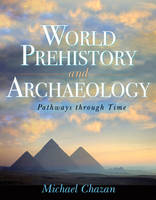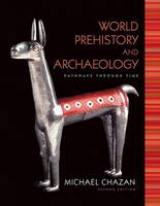
World Prehistory and Archaeology
Routledge (Verlag)
978-0-205-40621-0 (ISBN)
- Titel erscheint in neuer Auflage
- Artikel merken
Chazan brings students right up to the cutting edge of archaeological research by presenting the most recent discoveries and theoretical perspectives. How we know the past is inseparable fromwhat we know of the past. This new text allows students to see that archaeology is a dynamic field in which knowledge is continuously refined through scientific inquiry while providing a sense of the relevance of archaeology in the contemporary world.
As the cornerstone of this book is to present an integrated picture of prehistory as an active process of discovery, we cannot relegate methodological issues to the opening chapters alone. While the introduction to archaeological method in the first two chapters is necessary, the questions of how we know the past cannot be abandoned at that point. A number of features have been developed to draw together an integrated presentation of prehistory throughout the entire text.
Michael Chazan is an associate professor in the Department of Anthropology at the University of Toronto. He earned his Ph.D. in anthropology at Yale University. Before coming to Toronto, Dr. Chazan was a postdoctoral fellow with the Centre National de la Recherche Scientifique in Paris and at the Hebrew University in Jerusalem. Among his field experience are excavations in New Jersey, France, Israel, Jordan, Egypt, and South Africa. Dr. Chazan’s publications include a monograph on the Lower Paleolithic site of Holon, Israel, coauthored with Liora Horwitz. Dr. Chazan is currently engaged in a project on the Earlier Stone Age of South Africa: The project pulls together an international team of researchers to study a series of spectacular sites located in the Northern Cape Province.
(Each chapter begins with a Chapter Outline and Learning Objectives and concludes with a Summary, Key Terms, Review Questions, and For Further Reading section.)
Part I. The Past is a Foreign Country: Getting from Here to There
Chapter 1. Getting Started in Archaeology
1.1 READING THE LANDSCAPE
Survey Design
Geological Factors
Recovery Methods and GIS
1.2 EXCAVATION
Horizontal Excavation
Vertical Excavation
Geological Stratigraphy
Archaeological Sites Form
Archaeological Stratigraphy
Controlling Horizontal and Vertical Space
Recovery Methods
Recording Methods
1.3 ARTIFACTS AND ECOFACTS
1.4 BIASES IN PRESERVATION
1.5 QUANTIFICATION AND SAMPLING
Counting Bones
Counting Artifacts
1.6 CREATING A CHRONOLOGY
1.7 COMPARISON
1.8 CONSERVATION AND DISPLAY
Toolbox: Radiocarbon Dating
Toolbox: Ethnoarchaeology
Discovering the Past: Field School: A First Experience in Archaeology by Kristy E. Primeau
Chapter 2. Putting the Picture Together
2.1 ORIGINS OF ARCHAEOLOGY
2.2 THE EMERGENCE OF ARCHAEOLOGY
Organizing Time
The Establishment of Human Antiquity
Imperial Archaeology
2.3 DEVELOPING METHOD AND THEORY
Stratigraphic Method and Culture History
V. Gordon Childe
2.4 ARCHAEOLOGY AS SCIENCE
Developing Scientific Methods
The New Archaeology
Systems Theory
2.5 ALTERNATIVE PERSPECTIVES
Postprocessual Archaeology
Gender and Agency
Evolutionary Archaeology
2.6 ARCHAEOLOGY AT THE TROWEL’S EDGE
Toolbox: Thomas Jefferson: The Archaeologist
Archaeology in the World: Religion and Evolution
Discovering the Past: The Socialization Of Ancient Maya Children: Discovery at the Dancer Group Household In Northwestern Belize, Central America by Rissa M. Trachman
Discovering the Past: Different Views of a Site by Peter Robertshaw
Part II. Human Evolution
Chapter 3. Early Hominins
3.1 The Fossil Record
The Early Hominin Radiation
Australopithecines
Kenyanthropus
Paranthropus
Homo habilis
Homo erectus
3.2 Setting the Scene
The East African Rift Valley
Olduvai Gorge
Lower Paleolithic
The Oldowan
The Acheulian
3.3 The Origin of Tool Use
Tool Use by Animals
The Archaeological Evidence
3.4 Hunting and Sharing Food
Were They Hunters?
Living Floors and Base Camps
The Stone Circle at DK1
Assessing the Archaeological Evidence
The Use of Fire
3.5 The Expansion of the Hominin World
Ubeidiya and Dmanisi
East Asia
Java
Nihewan Basin
Summing Up the Evidence
Toolbox: Paleomagnetic Dating
Toolbox: Argon Dating
Toolbox: Stone Tools
Archaeology in the World: Fraud-- Piltdown and Kama takamori
Chapter 4. From Homo erectus to Neanderthals
4.1 DEFINING THE ICE AGE
4.2 BEFORE THE NEANDERTHALS
The Initial Occupation of Western Europe
The Acheulian Paradox
Beyond Stone Tools
4.3 NEANDERTHALS
Chronology and Ecology
Stone Tools
François Bordes and Neanderthal Ethnicity
The Binford-Bordes Debate
Dissenting Voices
The Frison Effect
The Chaîne Opératoire
Summing Up the Stones
Hunting
Stable Isotope Analysis
Site Organization and the Use of Fire
Treatment of the Dead
Artwork
Neanderthal Society
Toolbox: Oxygen Isotope Curve
Toolbox: Making a Levallois Flake
Toolbox: Micromorphology
Discovering the Past: A Paleo Epiphany by Lynne A. Schepartz
Chapter 5. The Origin of Modern Humans
5.1 What is a Modern Human?
5.2 Early Modern Humans in Africa
The African Middle Stone Age
Stone Tools
Bone Tools
Adaptation
Art
Comparing The Middle Stone Age and the Middle Paleolithic
5.3 Early Modern Humans in the Middle East
The Archaeological Record
Chronology
Assessing the Middle Eastern Pattern
5.4 The Arrival of Modern Humans in Europeand the Fate of the Neanderthals
The Fossil Record
Genetic Evidence
Archaeological Evidence
The Last Neanderthal
Summing Up the Evidence
5.5 The Upper Paleolithic
Chronology
Stone and Bone Tools
Human Burials
Art Work
Mobilary Art
Cave Art
Body Ornamentation
Site Structure
Subsistence
5.6 Explaining the Upper Paleolithic
Toolbox: Luminescence Dating Box 5.2 Toolbox: Interpreting Paleolithic Art
Toolbox: Usewear
Discovering the Past: Sibudu Cave: South African MSA Archaeological Field School By Tracy L. Kivell
Chapter 6. The Peopling of Australiaand the New World
6.1 Modern Humans in East Asia
6.2 Australia
Dating the Earliest Human Occupation
Megafauna Extinction
Rock Art
6.3 The New World
Clovis First
Clovis Culture and Chronology
Migration Routes
The Archaeological Evidence
Pre-Clovis
Meadocroft Rockshelter
Monte Verde
Caverna de Pedra Pintada
Quebrada Tacahuay
Coastal Migration
Early Arrival Model
The Solutrean Hypothesis
The Skeletal Evidence
Clovis Adaptations and Megafauna Extinction
Toolbox: Why are Folsom Points Fluted?
Toolbox: Radiocarbon Calibration
Archaeology in the World: Repatriation of Indigenous Burial Remains
Part III. Agricultural Beginnings
Chapter 7: Towers, Villages, and Longhouses
7.1 Setting the Scene
7.2 Stage 1: Kebaran and Geometric Kebaran
Technology
Settlements
Domestication
7.3 Stage 2: The Natufian
Technology
Settlements
Domestication
7.4 Stage 3: The Early Neolithic
Technology
Settlements
Ritual
Hidden
Display
Daily Life
Domestication
7.5 Stage 4: Late Neolithic
Technology
Settlement and Ritual
Domestication
7.6 Assessing the Neolithic Revolution
7.7
The Spread of Agriculture to Europe
Toolbox: Paleoethnobotany
Toolbox: Harris Matrix
Discovering the Past: The Iceman
Chapter 8 Mounds and Maize
8.1 Plant Domestication in Central America
8.2 Maize Agriculture in the American Southwest
The Formative Period
Summing Up the Evidence
8.3 Eastern North America
The Indigenous Domestication of Plants
The Adena and Hopewell
Intensification of Maize Agriculture
The People Behind the Transition
Summing Up the Evidence
Toolbox: AMS Radiocarbon Dating
Toolbox: Handbuilt Pottery
Toolbox: Isotope Analysis and Maize Agriculture
Discovering the Past: “Towns they have none:” In Search of New England’s Mobile Farmers by Elizabeth S. Chilton
Chapter 9: A Feast of Diversity
9.1 Africa
Villages of Hunter-Gatherers
Pastoralists
The First Farmers
Summing Up the Evidence
9.2 New Guinea
Clearing Forests and Draining Swamps
9.3 The Andes
Domestication in the Andean Highlands
Coastal Villages
The Cotton Preceramic
The Role of El Nino
Summing Up the Evidence
9.4 East Asia
Early Pottery
The First Farmers
The Development of Farming Societies
Summing Up the Evidence
9.5 Questioning the Neolithic
Discovering the Past: Researching the Origins of Agriculture in West Africa by Augustin F.C. Holl
Toolbox: Pollen, Phytoliths, and Starch Grains
Toolbox: Residue Analysis
Part IV: The Development of Social Complexity
Chapter 10: Complexity without the State
10.1 Stonehenge
The Development of Stonehenge
Phase 1–The Earthwork Circle
Phase 2–Burials and a Timber Structure
Phase 3–Stone Monument
Phase 3a-- The Bluestones
Phase 3b-- Sarsen Circle and Trilithons.
Phase 3c-f-- Rearranging bluestones and digging holes.
A Constructed Landscape
The Context of Stonehenge
What Did Stonehenge Mean?
Summing Up the Evidence
10.2 PuebloBonito, ChacoCanyon
The Development of Pueblo Bonito
The Function of Pueblo Bonito
Evidence for Elites
The Chaco Network
The Rise and Fall of Chaco Canyon
Summing Up the Evidence
10.3 Cahoka
The Layout of the Site
Evidence for Inequality
Feasting
Summing Up the Evidence
10.4 Great Zimbabwe
The Layout of the Site
The Function of the Enclosures
The Organization of Great Zimbabwe Society
Summing Up the Evidence
10.5 Comparative Perspectives
Discovering the Past: Why Do I “Do” Archaeology? by Joseph Watkins
Toolbox: Remote Sensing
Toolbox: Dendrochronology
Discovering the Past: Chavin de Huantar by John Rick
Chapter 11: The Urban State
11.1 Mesopotamia
The Physical Setting
Chronology
Uruk
Government
Surplus and Specialization
Inequality
The Development of Writing
Warfare and Expansion
Summing Up the Evidence
11.2 The Maya
Chronology
The Setting
The City
Government
Inequality
Maya Hieroglyphics
Ritual, Violence, Warfare
The Maya Collapse
Summing Up the Evidence
11.3 Shang China
11.4 The Urban State
Toolbox: Deciphering the Maya Hieroglyphs
Toolbox: Geophysical Methods
Archaeology in the World: The Fate of Iraq’s Antiquities
Discovering the Past: Rio Azul and the Classic Mayaby Fred Valdez
Discovering the Past: Ancient Maya and the Medicinal Trail Site by David Hyde
Chapter 12: Enigmatic States
12.1 Egypt
The Setting
Chronology
Government and Writing
The Pyramids
The Development of Mortuary Architecture
Hierakonpolis and Abydos
Saqarra and Daschur
Giza
The Pyramids and the State
The City
Amarna
Summing Up the Evidence
12.2 The IndusValley
The Setting and Chronology
The City
Writing
Government
Summing Up the Evidence
12.3 Jenne Jenno
Toolbox: Excavating Giza
Toolbox: Tracking Trade Routes
Archaeology in the World: The Trade in African Antiquities
Chapter 13: Empires
13.1 The Inca Empire
Before the Inca
The History of the Inca
Inca Society
Building Empire
Warfare
Roads
Khipu
Summing Up the Evidence
13.2 The Aztec Empire
Before the Aztecs
The History of the Aztecs
Aztec Economy
Ritual and Human Sacrifice
Summing Up the Evidence
13.3 Beyond Empires
Discovering the Past: Excavating the Land of the Lines by Lindsey Stoker
Toolbox: Tuberculosis in the Americas
Toolbox: Metallurgy
Epilogue: Bringing it Home
| Erscheint lt. Verlag | 26.4.2007 |
|---|---|
| Verlagsort | New York |
| Sprache | englisch |
| Maße | 276 x 217 mm |
| Gewicht | 1068 g |
| Themenwelt | Geschichte ► Allgemeine Geschichte ► Vor- und Frühgeschichte |
| ISBN-10 | 0-205-40621-1 / 0205406211 |
| ISBN-13 | 978-0-205-40621-0 / 9780205406210 |
| Zustand | Neuware |
| Informationen gemäß Produktsicherheitsverordnung (GPSR) | |
| Haben Sie eine Frage zum Produkt? |
aus dem Bereich



